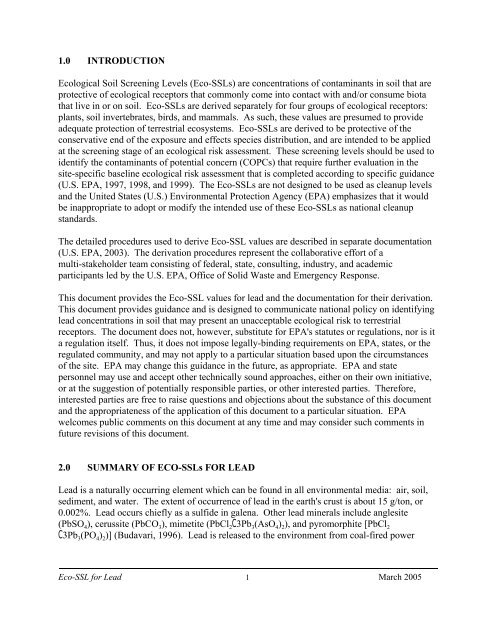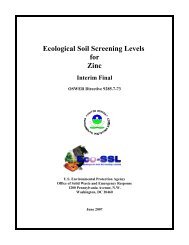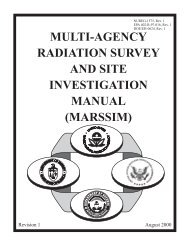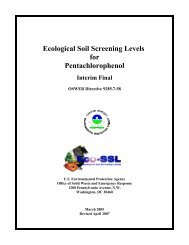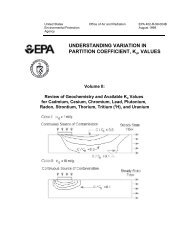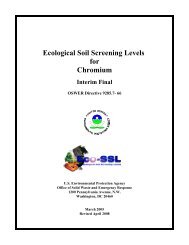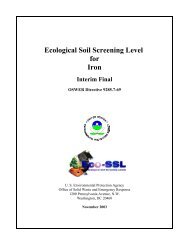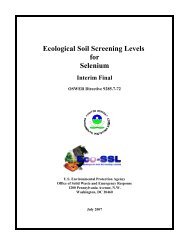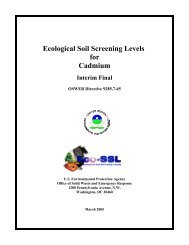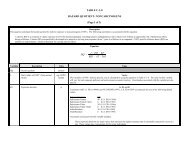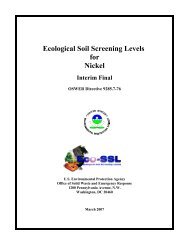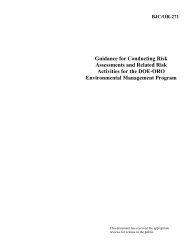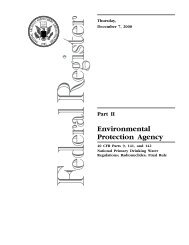C:\Eco-SSLs\Contaminant Specific Documents\Lead\November ...
C:\Eco-SSLs\Contaminant Specific Documents\Lead\November ...
C:\Eco-SSLs\Contaminant Specific Documents\Lead\November ...
Create successful ePaper yourself
Turn your PDF publications into a flip-book with our unique Google optimized e-Paper software.
1.0 INTRODUCTION<br />
Ecological Soil Screening Levels (Eco-SSLs) are concentrations of contaminants in soil that are<br />
protective of ecological receptors that commonly come into contact with and/or consume biota<br />
that live in or on soil. Eco-SSLs are derived separately for four groups of ecological receptors:<br />
plants, soil invertebrates, birds, and mammals. As such, these values are presumed to provide<br />
adequate protection of terrestrial ecosystems. Eco-SSLs are derived to be protective of the<br />
conservative end of the exposure and effects species distribution, and are intended to be applied<br />
at the screening stage of an ecological risk assessment. These screening levels should be used to<br />
identify the contaminants of potential concern (COPCs) that require further evaluation in the<br />
site-specific baseline ecological risk assessment that is completed according to specific guidance<br />
(U.S. EPA, 1997, 1998, and 1999). The Eco-SSLs are not designed to be used as cleanup levels<br />
and the United States (U.S.) Environmental Protection Agency (EPA) emphasizes that it would<br />
be inappropriate to adopt or modify the intended use of these Eco-SSLs as national cleanup<br />
standards.<br />
The detailed procedures used to derive Eco-SSL values are described in separate documentation<br />
(U.S. EPA, 2003). The derivation procedures represent the collaborative effort of a<br />
multi-stakeholder team consisting of federal, state, consulting, industry, and academic<br />
participants led by the U.S. EPA, Office of Solid Waste and Emergency Response.<br />
This document provides the Eco-SSL values for lead and the documentation for their derivation.<br />
This document provides guidance and is designed to communicate national policy on identifying<br />
lead concentrations in soil that may present an unacceptable ecological risk to terrestrial<br />
receptors. The document does not, however, substitute for EPA's statutes or regulations, nor is it<br />
a regulation itself. Thus, it does not impose legally-binding requirements on EPA, states, or the<br />
regulated community, and may not apply to a particular situation based upon the circumstances<br />
of the site. EPA may change this guidance in the future, as appropriate. EPA and state<br />
personnel may use and accept other technically sound approaches, either on their own initiative,<br />
or at the suggestion of potentially responsible parties, or other interested parties. Therefore,<br />
interested parties are free to raise questions and objections about the substance of this document<br />
and the appropriateness of the application of this document to a particular situation. EPA<br />
welcomes public comments on this document at any time and may consider such comments in<br />
future revisions of this document.<br />
2.0 SUMMARY OF ECO-SSLs FOR LEAD<br />
Lead is a naturally occurring element which can be found in all environmental media: air, soil,<br />
sediment, and water. The extent of occurrence of lead in the earth's crust is about 15 g/ton, or<br />
0.002%. Lead occurs chiefly as a sulfide in galena. Other lead minerals include anglesite<br />
(PbSO 4), cerussite (PbCO 3), mimetite (PbCl 2C3Pb 3(AsO 4) 2), and pyromorphite [PbCl 2<br />
C3Pb 3(PO 4) 2)] (Budavari, 1996). Lead is released to the environment from coal-fired power<br />
Eco-SSL for Lead 1<br />
March 2005


